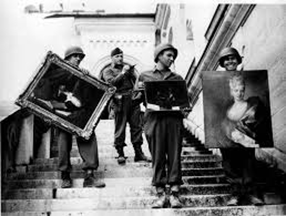Art theft and forgery have long had sexy celluloid reputations: from Peter O'Toole and Audrey Hepburn frolicking in How to Steal a Million to the Thomas Crown Affair, that, not once but twice, pedalled screen icons, first, Steve McQueen and Faye Dunaway, and latterly Piers Bronson and Rene Russo.... And now the silver fox himself, George Clooney, has stepped into the breach with The Monuments Men. Based on the true story of the greatest treasure hunt in history, The Monuments Men focuses on an unlikely World War II platoon, tasked by Franklin D Roosevelt with going into Germany to rescue artistic masterpieces from Nazi thieves and to return them to their rightful owners. Clooney stars alongside Matt Damon, Cate Blanchett and John Goodman. For once, Hollywood throws the spotlight away from glamorising art theft and instead focuses on the heroic ventures of a disparate band of brothers - museum directors, curators and art historians - attempting to save some of the world's greatest masterpieces. Released in London on 14th February, it may be where many art lovers have planned to spend their Valentine soiree - or at least until Clooney tried to get clever over the Elgin marbles!
Stolen art seems to be at the heart of the zeitgeist and it is something that has always fascinated me. I remember visiting the Isabella Stewart Gardner Museum in Boston over 20 years ago and feeling a mixture of shock and sadness at the barren frames still hanging on the damask-lined walls that used to hold extremely rare works by Rembrandt and Vermeer.

The release of The Monuments Men swiftly follows the Victoria & Albert museum's publication of the definitive list termed by the Nazis as 'degenerate art', Donna Tartt's marathon tome, The Goldfinch, which hinges on a Dutch old master painting and the recent discovery of a hoard of works of art estimated to be valued at £846m found in a modest Munich apartment. Owned by Cornelius Gurlitt, the paintings were inherited from his father, Hildebrand, who sold works confiscated or bought by the Nazis. These are now the subject of an ongoing court battle.
Finally, at the end tail end of last year, BBC2 aired Alastair Sooke's excellent investigative programme, 'The World's Most Expensive Stolen Paintings', where Sooke challenged many of the more glamorous myths surrounding the theft of art and exposed the murky criminal world for what it is - a far cry from the sophisticated criminal Thomas Crown. Earlier in 2013, the FBI announced that the Gardner Museum case had been 'solved', but none of the missing works have been recovered and nobody has been prosecuted - indeed it seems that, due to time past, they can no longer prosecute those involved. In total, 13 works of art, including a portrait by Manet, five sketches by Degas, the only known seascape by Rembrandt, and - perhaps most heartbreakingly - The Concert by Vermeer, one of only around 36 extant paintings by the 17th-century Dutch master, were stolen. Today this haul is valued at more than $500 million (£305 million). Sooke managed to interview the 'mastermind' of the heist who, as fate would have it, was arrested the very night he had planned the job and insists that it was his partners who carried it out instead.
The notion of a criminal connoisseur in the mould of Dr. No may be a myth, but the brutal reality is that everyday thieves and thugs do steal art - and lots of it. Perhaps one of the reasons we remain fascinated is that many of the cases remain unsolved - and we all love a fiendish mystery - but I for one would like more of them solved.
